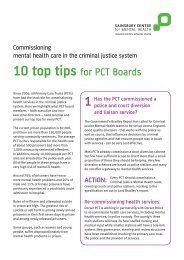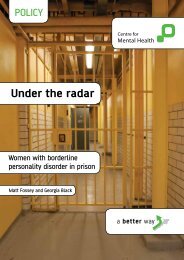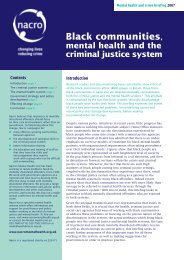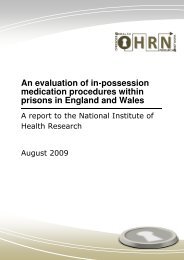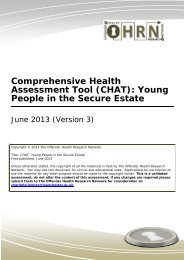Engendering Justice - from Policy to Practice - The Fawcett Society
Engendering Justice - from Policy to Practice - The Fawcett Society
Engendering Justice - from Policy to Practice - The Fawcett Society
- No tags were found...
You also want an ePaper? Increase the reach of your titles
YUMPU automatically turns print PDFs into web optimized ePapers that Google loves.
Female offenders serving indeterminate sentences find itdifficult <strong>to</strong> access accredited programmes that are nowan accepted route <strong>to</strong> prove fitness for release. Accreditedprogrammes such as those <strong>to</strong> develop cognitive skills haveproven effective in helping male offenders address theiroffending behaviour. No such body of evidence exists <strong>to</strong>support their efficacy with women and, indeed, very fewprogrammes have been developed which are appropriate<strong>to</strong> women. As with education and training programmes,there needs <strong>to</strong> be a separate strand of work which reflectsthe different learning styles of women. Developmentalprogrammes specific <strong>to</strong> women’s needs need <strong>to</strong> beaccorded the same status in the journey <strong>to</strong>wards release asthe traditional male accredited programmes.<strong>The</strong> Differentiated Needs of WomenIt is important for any consideration of the needs of womenoffenders <strong>to</strong> take in<strong>to</strong> account that women are not ahomogenous group. Women will have differentiated needsaccording <strong>to</strong> their experiences as well as the intersectionbetween gender and other inequalities. For example, ethnicminority women are substantially overrepresented amongthe prison population, comprising 22.3 percent of thefemale British prison population. 69 Further, fac<strong>to</strong>rs such aswhether a woman is a mother or past his<strong>to</strong>ries of violenceand abuse will also impact on the effect of cus<strong>to</strong>dy on awoman.Women <strong>from</strong> Black and Minority Ethnic GroupsOn 30 June 2007, 29 percent of women in prison were <strong>from</strong>a black and ethnic minority background. 70 Women <strong>from</strong>minority groups are more likely <strong>to</strong> feel unsafe in prison andless likely <strong>to</strong> feel they are treated with respect <strong>from</strong> prisonstaff. 71 <strong>The</strong> concentration of ethnic minority communities incities also makes ethnic minority women more likely <strong>to</strong> beisolated <strong>from</strong> their families and <strong>to</strong> receive fewer visits due<strong>to</strong> the location of the prisons in the female estate. This alsocreates difficulties for these women in relation <strong>to</strong> accessingresettlement support.<strong>The</strong>re is a lack of understanding of the needs of blackprisoners. For example African-Caribbean hair oil is anecessity, not a luxury, but it has <strong>to</strong> be ordered throughthe canteen system which is slow and often chaotic. 72Women also commented that they did not receive anyconsideration for their religious needs throughout thecriminal justice process.BME women and foreign nationals are more likely <strong>to</strong>experience isolation in cus<strong>to</strong>dy leading <strong>to</strong> increased levelsof depression. Further, BME women may also be lesslikely <strong>to</strong> seek help <strong>from</strong> staff. This needs <strong>to</strong> be proactivelyaddressed. Many prison workers who shared their viewswith the Commission also noted that language was a barrierfor BME women. As one prison worker explained:For black and minority ethnic women, the biggestproblem is communication and language barriers. I knowwe’ve got language line but there are not enough bilingualstaff. Prison rules, literature etc. is not printed in otherlanguages. 73<strong>The</strong> use of interpreters and the employment of staff whospeak the languages of ethnic minority women should beimplemented within the female estate. Further, staff shouldbe trained in some basic words <strong>from</strong> the most commonlanguages.Significantly, the Prison Service Order on Women Prisonersprovides guidance specifically in relation <strong>to</strong> BME womennoting needs such as <strong>to</strong>iletries, health care, access <strong>to</strong> awide range of faith representatives and courses and trainingwhich take taking in<strong>to</strong> account different cultures. 74 This isan important step but this policy needs <strong>to</strong> be translated in<strong>to</strong>practice and the complexities of the intersection betweengender and racial discrimination within the criminal justicesystem and the attitudes <strong>to</strong> offending and attached stigmawithin various communities requires further research.One of the critical barriers <strong>to</strong> understanding the needs ofethnic minority women and their patterns of offending is thelack of data which is available on these women and theirdistinctive needs. As one female ex-prisoner commented:Page 37







